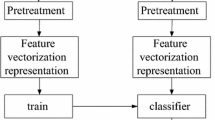Abstract
The performance of an Information Retrieval system is very much dependent on the effectiveness of the relevance model being used. Motivated by the concepts in Collision Theory in Physics, this paper proposes a novel approach of identifying relevance between two text objects. The role of positive and negative features is considered in designing the relevance measure based on the transitions in Collision Theory. For evaluating the measure, we have applied our relevance model on sentiment classification.
Access this chapter
Tax calculation will be finalised at checkout
Purchases are for personal use only
Preview
Unable to display preview. Download preview PDF.
Similar content being viewed by others
References
Mizzaro, S.: How many relevances in information retrieval? Interacting with Computers, 303–320 (1998)
Metzler, D., Dumais, S.T., Meek, C.: Similarity Measures for Short Segments of Text. In: Amati, G., Carpineto, C., Romano, G. (eds.) ECIR 2007. LNCS, vol. 4425, pp. 16–27. Springer, Heidelberg (2007)
Zhang, M., Ye, X.: A Generation Model to Unify Topic Relevance and Lexicon-based Sentiment for Opinion Retrieval. In: Proceedings of 31st Annual International ACM SIGIR Conference on Research and Development in Information Retrieval, pp. 411–418 (2008)
Harwit, M.: Astrophysical Concepts, 4th edn. Springer (2006)
Murugeshan, M.S., Mukherjee, S.: A Collision Theory Inspired Model for Categorization of Wikipedia Documents. European Journal of Scientific Research 56(3), 396–403 (2011)
Pang, B., Lee, L., Vaithyanathan, S.: Thumbs up? Sentiment Classification using Machine Learning Techniques. In: Proceedings of the Conference on Empirical Methods in Natural Language Processing (EMNLP 2002), pp. 79–86 (2002)
Kennedy, A., Inkpen, D.: Sentiment Classification of Movie Reviews Using Contextual Valence Shifters. Computational Intelligence 22(2), 110–125 (2006)
Yu, H., Hatzivassiloglou, V.: Towards Answering Opinion Questions: Separating Facts from Opinions and Identifying the Polarity of Opinion Sentences. In: Proceedings of the Conference on Empirical Methods in Natural Language Processing (EMNLP 2003), pp. 129–136 (2003)
Tang, H., Tan, S., Cheng, X.: A survey on sentiment detection of reviews. Expert Syst. Appl. 36(7), 10760–10773 (2009)
Li, S., Lee, S.Y.M., Chen, Y., Huang, C., Zhou, G.: Sentiment Classification and Polarity Shifting. In: Proceedings of the 23rd International Conference on Computational Linguistics (COLING 2010), pp. 635–643 (2010)
van Rijsbergen, C.J.: The Geometry of Information Retrieval. Cambridge University Press, New York (2004)
Piwowarski, B., Lalmas, M.: A Quantum-Based Model for Interactive Information Retrieval. In: Azzopardi, L., Kazai, G., Robertson, S., Rüger, S., Shokouhi, M., Song, D., Yilmaz, E. (eds.) ICTIR 2009. LNCS, vol. 5766, pp. 224–231. Springer, Heidelberg (2009)
Shi, S., Wen, J., Yu, Q., Song, R., Ma, W.: Gravitation-Based Model for Information Retrieval. In: Proceedings of the 28th International Conference on Research and Development in Information Retrieval (SIGIR 2005), pp. 488–495 (2005)
Murugeshan, M.S., Sampath, A., Ahmed, F., Ashok, B., Mukherjee, S.: Effect of Modifiers for Sentiment classification of Reviews. In: Proceedings of the 6th International Conference on Natural Language Processing (ICON 2008), pp. 157–164 (2008)
Blitzer, J., Dredze, M., Pereira, F.: Biographies, Bollywood, Boom-boxes and Blenders: Domain Adaptation for Sentiment Classification. In: Proceedings of the Association of Computational Linguistics (ACL), pp. 440–447 (2007)
Author information
Authors and Affiliations
Editor information
Editors and Affiliations
Rights and permissions
Copyright information
© 2012 ICST Institute for Computer Science, Social Informatics and Telecommunications Engineering
About this paper
Cite this paper
Murugeshan, M.S., Mukherjee, S. (2012). Novel Relevance Model for Sentiment Classification Based on Collision Theory. In: Das, V.V., Stephen, J. (eds) Advances in Communication, Network, and Computing. CNC 2012. Lecture Notes of the Institute for Computer Sciences, Social Informatics and Telecommunications Engineering, vol 108. Springer, Berlin, Heidelberg. https://doi.org/10.1007/978-3-642-35615-5_67
Download citation
DOI: https://doi.org/10.1007/978-3-642-35615-5_67
Publisher Name: Springer, Berlin, Heidelberg
Print ISBN: 978-3-642-35614-8
Online ISBN: 978-3-642-35615-5
eBook Packages: Computer ScienceComputer Science (R0)




